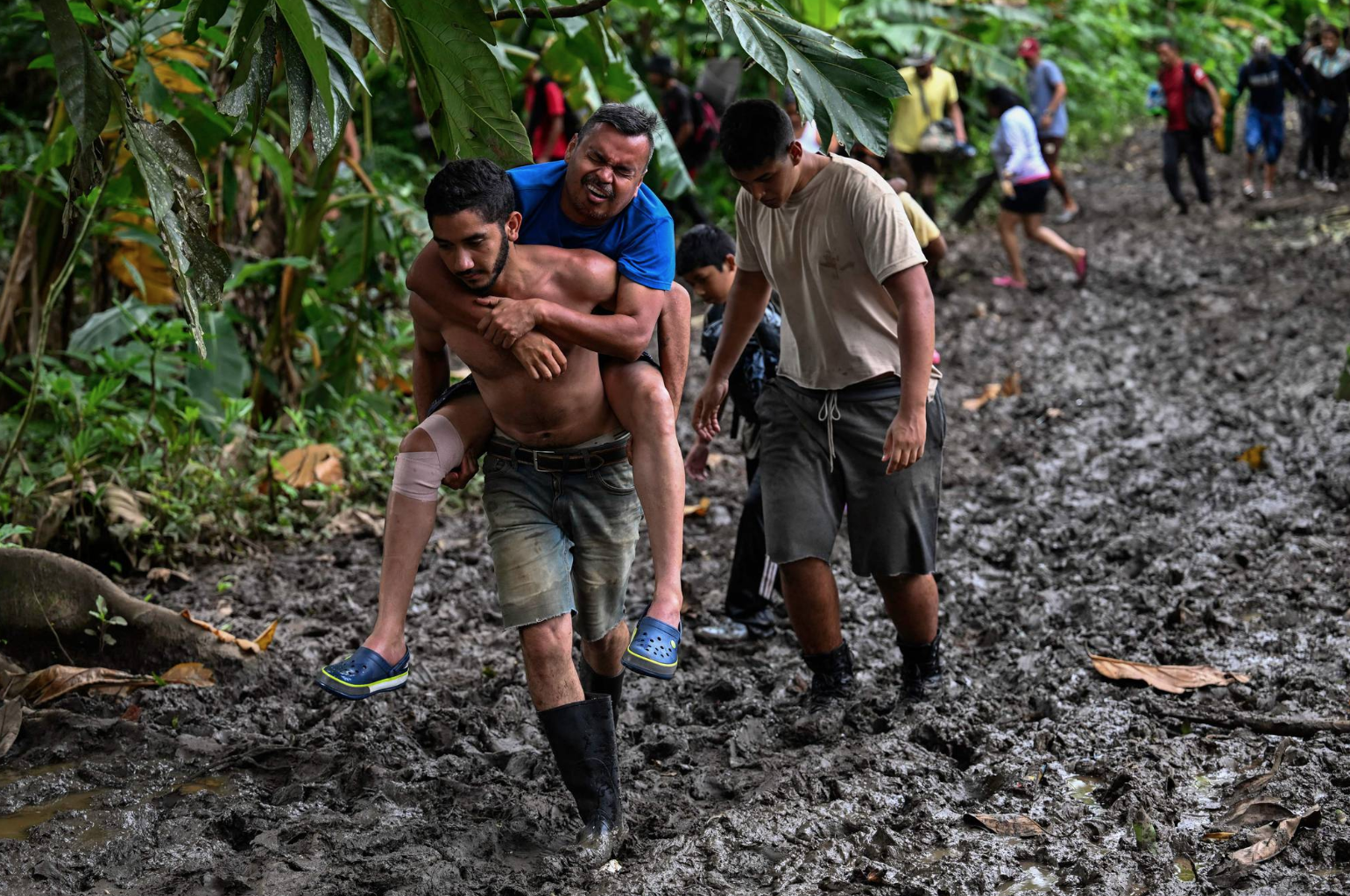
In 2021, roughly 133,000 asylum seekers traversed the perilous Darien Gap in their quest to reach the United States. In 2022, the number nearly doubled and, in the first months of 2023, over 100, 000 migrants have made the attempt, a number predicted to surpass 400,000 by the end of the year. The number of asylum seekers is not what should cause us alarm, however. Instead, what provokes our concerns is the danger these desperate migrants from Venezuela, Haiti, Ecuador, Cuba, Senegal, Ghana, Somalia, Guinea, Congo, Burkina Faso, and many others must endure to reach the United States crossing Darien.
The Darien Gap is a 66-mile long and 30-mile wide area between Colombia and Panama. It consists of jungle, dense rain forest, steep mountains, vast swamps and rivers that too often pull children from their parents’ arms and sweep migrants to their death. On top of that, the route is crawling with smugglers, members of the ex FARC, and other criminal elements that rob, rape, murder, kidnap, and sell vulnerable migrants into human trafficking rings.
Ostensibly in response to this growing humanitarian calamity, on April 11, 2023, The United States Department of Homeland Security released a trilateral statement from the foreign ministers of the United States, Panama, and Colombia announcing a plan to “address the serious humanitarian situation in the Darien.” The 60-day plan aims to achieve three things.
First to end the illicit movement of people and goods through the Darien by both land and maritime corridors. Second, open new lawful and flexible pathways for tens of thousands of migrants and refugees. And third, to launch a plan to reduce poverty, improve public service delivery, create jobs, and promote economic and sustainable opportunities in border communities in northern Colombia and southern Panama.
The announcement was met with near-immediate criticism. “Al Otro Lado“, an organization assisting migrants and refugees in the U.S. and Mexico, criticized the apparent lack of feasibility of the plan. Immigration policy non-profit Haitian Bridge Alliance decried the plan as “terrifying” because it will likely require militarization of the Colombian border, and thus, will increase the dangers of crossing. I will add to these astute criticisms by suggesting yet another, namely that the plan reflects and perpetrates global oppression via further externalization of U.S. border and immigration policy.
First, this trilateral plan is the latest example of the U.S. is externalizing its immigration policy and extending the U.S.-Mexico border further south to prevent people from reaching the United States territory where they can legally request asylum. For example, in 2014, Mexico implemented its Southern Border Plan (Plan Frontera Sur), so Mexico could stop Central American migrants before they reach the U.S. Southern Border. During the Trump Administration, the U.S. brokered “third party agreements” with Guatemala, El Salvador, and Honduras to accept asylum seekers en route to the United States so that they do not come to the U.S. Accompanying this, the U.S. also started requiring would-be asylum seekers from Central America to request refuge in one of these countries or Mexico before doing so in the U.S. The Trump Administration also implemented the Migrant Protection Protocols requiring would-be asylum seekers to Mexico to wait for their requests to be adjudicated and activated Title 42, a public health policy, to allow border patrol to expel migrants without documents without processing them.
The trend continues with the Biden Administration. In October 2022, the Administration announced a plan to grant 24000 humanitarian visas to Venezuelan migrants with sponsors in the U.S. while simultaneously making Venezuelans ineligible for seeking asylum if they do not enter the United States through an authorized entry point. Moreover, the termination of Title 42, has put extra pressure on the Administration to control who arrives at the border (reverting to the previous laws allowing anyone to request asylum anywhere on U.S. soil). The Biden Administration is trying, again, to prevent people from reaching the U.S. This trilateral plan is simply the latest in these efforts.
As I said before, I find these policies problematic for a variety of reasons, but principally because they create, reflect, and perpetuate global oppression in various ways. Global oppression occurs when a nation’s policies and practices come together to place nations, transnational communities, and their members into double binds that ensure they have no adequate options and are vulnerable to negative consequences regardless of what they do. Moreover, they are placed in these double binds simply because they are members of those nations or transnational communities. And none of this is accidental, random, or avoidable, but rather results from the nation’s policies and practices of a nation working well. This trilateral agreement is the latest policy that externalizes the U.S. border to reflect and promote global oppression.
First, the plan to halt migration through the Darien is neither random nor accidental. On the contrary, as just shown, it is part of a larger network of policies and practices intended to stop would-be asylum seekers from reaching the U.S. As such, we should see that policy as part of a larger oppressive U.S. immigration system.
Second, the plan puts Venezuelan migrants into double binds, just because they are Venezuelan and poor. In other words, they can either stay in Venezuela and suffer the well-documented harms from doing so (hunger, lack of health care, violence, political repression, etc.), or they can risk the journey through South and Central America. Their lives are endangered regardless. Now, one could point to the fact that the Administration is permitting some Venezuelans to enter via airports, but this is not an option for poor Venezuelans. In this way, Venezuelan asylum seekers are restricted because of both their nationality and social class.
Still, some may argue that the United States is tightening asylum access for everyone, not just Venezuelans. The problem is that the evidence suggests otherwise. Take, for example, the Administration’s stance in relation to Ukrainian refugees. While the United States has welcomed over 271,000 Ukrainian refugees since the Russian invasion, in the October 2022 plan, the Administration announced that it would issue a mere 24, 000 visas to Venezuelans, despite this being one of the largest displacements in the world. This differential response lends credence to the idea that Venezuelans are being limited because they are Venezuelans.
Third, the plan will likely increase the dangers asylum seekers face – either because they need to endure the jungle without humanitarian assistance, have to pay smugglers to take them on routes that evade officials, or will encounter militaries preventing them from entering the Darien. As Joseph Carens so famously put it, “borders have guards and guards have guns.” Under these circumstances, asylum seekers systematically face potential violence from even more fronts than before.
Finally, while Colombia and Panama are clearly actors in this plan, I am worried that it promotes U.S. interests over those of Colombia and Panana. At minimum, the fact that the U.S. electorate is currently more xenophobic toward Latin American migrants does not entail that other nations need to help them prevent their Latino(a) brothers and sisters from reaching their Southern border. On the contrary, these nations could (and for most of history did) just let these migrants pass through their countries and offer protection. But the fact that they chose against this, in my judgment, reflects a dominant relationship rooted in a long history of U.S. intervention in the region.
To be clear, it is possible that the U.S., Panama, and Colombia want to protect migrants from an incredibly dangerous journey that puts them all at risk. But I don’t think this is the plan to do it. So, let’s keep thinking about better ways to help these migrants build bright futures without repeating the oppressive patterns of the past.


